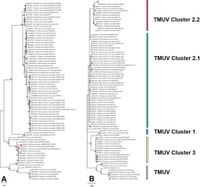In a groundbreaking discovery, researchers have identified Tembusu virus (TMUV) as a significant threat to dolphins, marking the first recorded instance of this avian pathogen infecting mammals. Three bottlenose dolphins housed in a private zoo in Thailand tragically succumbed to TMUV infection, an emerging flavivirus primarily linked to avian diseases but now recognized for its zoonotic potential.
The dolphins exhibited alarming neurological symptoms, including decreased coordination and body tremors, before ultimately dying in July 2023. The total clinical course spanned about one month—from the onset of symptoms in the first dolphin to the fatal outcomes of all three. Neuropathological examinations confirmed the presence of TMUV, with high viral loads detected in brain and lung tissues, and immunohistochemistry revealing viral antigens specifically localized in neurons and astroglial cells.
This alarming event illustrates not only the adaptability of TMUV but also the virus’s potential to infect diverse species, including humans. Its association with avian species, historically causing severe disease in ducks and evidenced by significant economic losses in poultry agriculture, poses important questions about cross-species viral transmission.
Preparation for this research included post-mortem examinations and advanced techniques such as high-throughput sequencing, which uncovered a complete 10,963-bp TMUV genome that shared remarkable similarity with strains found in mosquitoes in China. Phylogenetic analysis positioned the dolphin-derived TMUV strains within cluster 3, suggesting deeper evolutionary connections and broadening insights into the virus's host range.
The presence of TMUV in marine mammals such as dolphins indicates not only the viral adaptation mechanisms but also raises urgent concerns regarding the pathways of transmission. Researchers pointed out that although the dolphins were housed separately, potential intermediaries—like mosquitoes capable of biting both birds and mammals—could facilitate such infections.
Furthermore, retrospective analyses of archival samples revealed that TMUV may have been circulating among captive dolphins since 2019, highlighting ongoing risks and the need for robust surveillance programs across animal populations.
This study emphasizes the importance of a comprehensive One Health approach to address the dynamic interrelations between human, animal, and environmental health systems as viral pathogens evolve and emerge. With their alarming findings, the authors contend that vigilance and ongoing research are essential in characterizing the TMUV strain’s adaptations, potential reservoirs, and vectors to curb similar outbreaks in the future.

